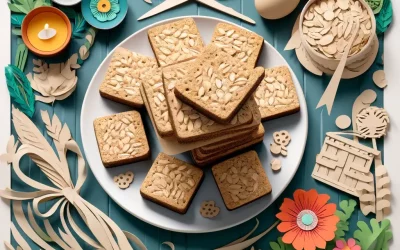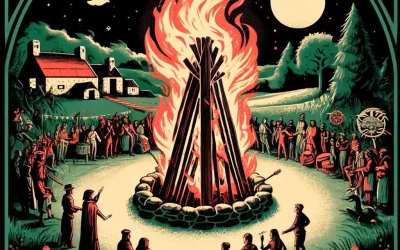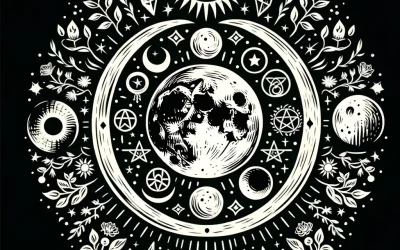LEARN | PAGAN HOLIDAYS | BELTANE
EVERYTHING YOU NEED TO KNOW ABOUT BELTANE
Residing midway between the spring equinox and summer solstice epitomizes the shift from spring to summer.
Updated: April 14, 2024
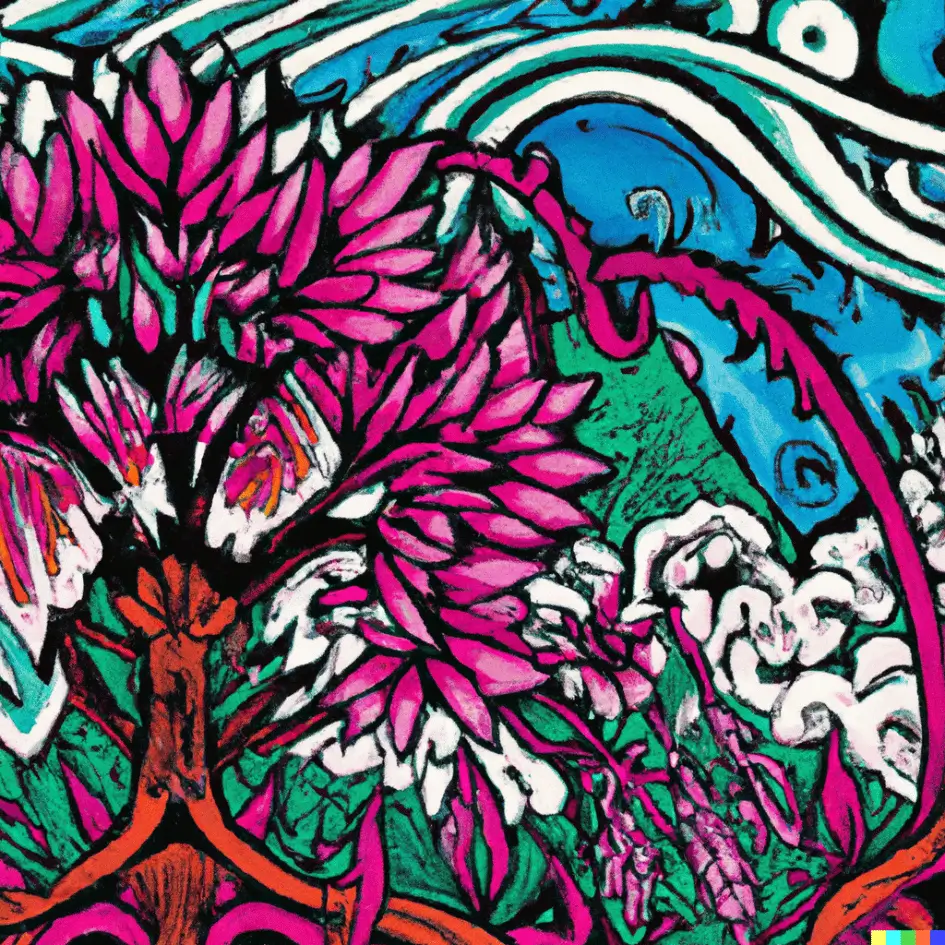
Beltane 2024
When is Beltane?
In 2024 May 1st, is the celebration of Beltane. Timing can fluctuate slightly, depending on local and cultural customs. Some individuals may commemorate Beltane on the eve of April 30th, known as Beltane Eve or Walpurgis Night. Alternatively, others might opt to honor it according to the astronomical midpoint between the vernal equinox and the summer solstice, occurring between April 30th and May 6th. Contemporary Pagan communities may also observe Beltane over several days, accommodating diverse schedules and inclinations.
Astrological Insights – Beltane 2024
At 12:30 AM on May 1st, Venus will square Pluto.
What is Beltane
Beltane is a Pagan Gaelic fire festival celebrated May 1st, marking the vibrant transition from spring to summer. Beltane stands at the midpoint between the spring equinox and the summer solstice, heralding the light half of the year.
Unlike the modern astronomical definition of seasons, which places the start of summer at the June solstice, Beltane is based on the traditional agrarian calendar. This calendar observes the beginning of summer from the evidence of nature itself—increased warmth, the blooming of plants, and the fertile earth ready to sow crops.
How to Pronounce Beltane
Beltane is pronounced, “BELL-tayn.” Now, you can confidently talk about it without that awkward pause where you try to figure out if you’re saying it right. You’re welcome.
The Colors, Crystals, Scents, Herbs, Plants, Flowers, and Symbols of Beltane
Embark on a vivid odyssey through Beltane’s symbolic spectrum, delving into its vibrant hues, hallowed flora, enchanting blossoms, mystical herbs, and potent crystals, all resonating with the celebration’s life-affirming energies. These elements pertain to Beltane as they personify themes of love, fertility, growth, and prosperity that typify the festival.
Colors
- Green: symbolizes growth, abundance, and the lushness of nature during spring.
- Red: represents passion, love, and the fiery energy of the festival.
- White: signifies purity, light, and divine feminine energy.
Crystals
- Emerald: symbolizes love, fertility, and abundance.
- Rose Quartz: represents unconditional love, compassion, and harmony.
- Carnelian: signifies vitality, courage, and creativity.
- Malachite: symbolizes transformation, growth, and abundance.
Scents
- Jasmine: associated with love, sensuality, and spiritual connection.
- Rose: signifies love, beauty, and divine feminine energy.
- Sandalwood: represents purification, protection, and spiritual connection.
- Ylang-Ylang: symbolizes love, sensuality, and relaxation.
Symbols
- Maypole: represents the union of masculine and feminine energies and fertility.
- Fire: symbolizes purification, protection, and transformation.
- Green Man/Jack-in-the-Green: embodies the spirit of nature and vegetation.
Herbs, Plants, and Flowers
- Hawthorn: associated with fertility, love, and protection.
- Lily of the Valley: symbolizes happiness and the return of joy in spring.
- Primrose: represents youth, love, and growth.
- Rose: signifies love, beauty, and the divine feminine.
- Elder: offers protection and is believed to ward off evil spirits.
The Significance of Beltane
Beltane is more than just a celebration of the arrival of summer; it is an acknowledgment of the ever-changing cycles of nature and a reminder to embrace the warmth, light, and abundance the season brings. By honoring Beltane, we connect with our ancestral roots and the enduring beauty of the earth.
A Timeline: Beltane’s Transformation Over Centuries
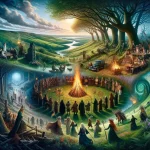 As the wheel of time spun from the Middle Ages into modernity, Beltane’s face got painted with the brush of changing beliefs, cultures, and even politics. Think of it as the original festival getting a series of reboots, each time with a slightly different cast.
As the wheel of time spun from the Middle Ages into modernity, Beltane’s face got painted with the brush of changing beliefs, cultures, and even politics. Think of it as the original festival getting a series of reboots, each time with a slightly different cast.
The Early Days (Up to the 4th Century):
Back in the day, Beltane was the blockbuster event of the Celtic calendar, a mix of live-action and nature documentary all rolled into one. People gathered to ignite massive bonfires, not just for the ‘gram (had it existed), but as a spiritual firewall against malevolent forces and a booster for the land’s fertility. It was earthy, raw, and connected—everyone tuned into nature’s rhythm, celebrating the warmth and the promise of a fruitful summer.
The Early Middle Ages (5th to 10th Century):
As the world began its slow pivot towards Christianity, Beltane clung to its roots but started to don a bit of a disguise. The bonfires still blazed, but now they flickered alongside Christian feast days, blending the old with the new. Communities found ways to weave Beltane’s themes of fertility and renewal into the fabric of a rapidly changing cultural tapestry, ensuring the festival’s spirit danced on through the integration of pagan customs with Christian celebrations.
High and Late Middle Ages (11th to 15th Century):
By now, Beltane was like an underground classic—a tradition that refused to bow out despite societal pressures. As feudalism took hold and Europe became more urbanized, Beltane’s practices shifted subtly. In rural outposts, where the old ways held sway, Beltane became a more intimate affair. Small bonfires lit private lands, and the festival’s focus on community and agricultural blessings became a quiet act of resistance and affirmation of identity.
The Renaissance and Reformation (16th to 17th Century):
The plot thickens as Beltane navigates the drama of the Reformation and the Renaissance. Here, the festival’s public face dimmed in places where religious and political reforms frowned upon pagan rites. Yet, in whispers and winks, Beltane survived—reinvented in private celebrations, its essence preserved in folk plays, maypoles disguised within May Day celebrations, and in the resilience of communities that kept the old ways alive in secret.
The Victorian Era (19th Century):
Enter the Victorians, with their penchant for pageantry and a polished version of the past. Beltane received a makeover in the form of antiquarian interest and folklore revival. This era saw Beltane as a cultural curiosity, celebrated with a blend of earnest revival and a sanitized version of its pagan roots. Maypoles and floral crowns enjoyed a renaissance, albeit through a lens that emphasized spectacle over spiritual significance.
Modern Times (20th Century to Present):
Today, Beltane booms in a symphony of old and new. It’s celebrated with gusto across the globe, from traditional fire ceremonies that honor its ancient roots to eco-conscious festivals that reflect contemporary values. Beltane has embraced inclusivity, environmentalism, and community on a global scale, proving that even the oldest traditions can find new life in the modern world. Its adaptation speaks to a universal yearning for connection with nature, cycles of life and death, and the communal joy of spring’s return.
The Modern Face of Beltane: Ancient Traditions in Today’s World
Today, Beltane has morphed from ancient fire festival to a celebration that resonates across the globe, connecting those of us living in a digital age to the rhythms of the earth and the cycle of the seasons. It’s like Beltane went from underground cult classic to a mainstream hit, but in the best way possible.
Adapting Ancient Traditions
In the current era, Beltane is less about survival and more about revival—of the planet, of community, and of ourselves. It’s celebrated with an old-school reverence for nature and a modern twist on rituals. Think global drum circles, virtual maypole dances, and planting trees instead of just flowers. It’s a day when the ancient and the contemporary dance together, proving that some traditions are too vibrant to ever really fade away.
The Goddesses of Beltane
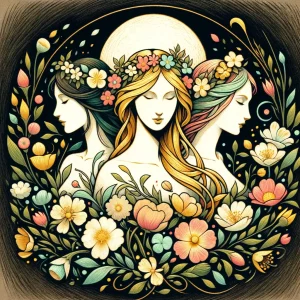 Several goddesses are associated with the themes of fertility, growth, and love that Beltane celebrates. The nature of Celtic mythology, with its emphasis on the cyclical and interconnected aspects of life, means that many deities can be relevant to the themes of Beltane. Here are a couple of examples:
Several goddesses are associated with the themes of fertility, growth, and love that Beltane celebrates. The nature of Celtic mythology, with its emphasis on the cyclical and interconnected aspects of life, means that many deities can be relevant to the themes of Beltane. Here are a couple of examples:
Flora
At the heart of Beltane’s lush celebrations stands Flora, the Roman goddess of flowers, spring, and fertility. Her essence is interwoven with the very fabric of Beltane, embodying the festival’s vibrant celebration of life, renewal, and the blossoming of the natural world. As the goddess who breathes life into spring’s floral tapestry, Flora symbolizes the abundance and beauty that Beltane heralds.
Aine
Aine is an Irish goddess often associated with summer, wealth, sovereignty, and fertility. She is particularly connected to the sun and the energy it brings to encourage growth. As a goddess of love and fertility, Aine’s connection to Beltane is through the vitalizing power of the sun and the fertility of the land. Celebrations in her honor involve lighting torches or bonfires, which aligns with Beltane’s fire rituals.
Brigid
Although Brigid is more traditionally linked with Imbolc, her themes of fertility, inspiration, and the protective and healing aspects of fire make her relevant to Beltane as well. Brigid embodies the light half of the year, and her sacred flames and wells represent purification and renewal—key aspects of the Beltane celebration.
May Queen, or Maiden Goddess
While not a specific named deity, the May Queen personifies the earth in bloom, the perfect symbol for Beltane’s celebration of spring’s full swing. Imagine Mother Nature in her prom dress, if you will.
The Green Man: Emblem of Beltane Renewal
<The Green Man, a figure representing the spirit of vegetation and the renewing power of nature, is intricately woven into the fabric of Beltane celebrations. Symbolizing growth, rebirth, and the cyclic nature of life, this emblematic figure captures the essence of Beltane, a festival that heralds spring’s peak and summer onset.
Origins and Symbolism
The Green Man is depicted as a face surrounded by or made of leaves, branches, and vines, sometimes sprouting foliage from the mouth, ears, and other facial openings, embodying the union between humanity and nature. This figure appears in various cultures and periods, often carved into the wood and stone of medieval churches and ancient temples, serving as a powerful motif of rebirth and the cyclical growth of the natural world.
Association with Beltane
During Beltane, the Green Man is often personified in parades and rituals, symbolizing the return of greenery and the fertile earth’s abundance. He is seen as a guardian of all living things, and his presence reinforces the connection between the community and the natural world’s cycles. Celebrations may include crafting masks that resemble his foliage-adorned face, enacting plays or dances that tell the story of the seasons’ cycle, and invoking his spirit to bless the land and its inhabitants with vitality and growth.
Beltane and the Faeries: A Little Mischief, A Lot of Magic
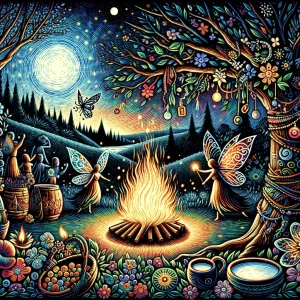 Beltane is a time when the veil between the human world and the realm of the fae is at its thinnest. This timing makes interactions with the fairy folk more likely and potent. The faeries, or “Aos Sí” in Gaelic culture, are considered powerful beings that can bestow blessings as easily as they can create mischief. Beltane’s fires, festivities, and the renewal of nature intensify this connection, inviting the faeries to partake in the celebration and, in turn, drawing humans closer to the mystical world.
Beltane is a time when the veil between the human world and the realm of the fae is at its thinnest. This timing makes interactions with the fairy folk more likely and potent. The faeries, or “Aos Sí” in Gaelic culture, are considered powerful beings that can bestow blessings as easily as they can create mischief. Beltane’s fires, festivities, and the renewal of nature intensify this connection, inviting the faeries to partake in the celebration and, in turn, drawing humans closer to the mystical world.
The Role of Faeries in Beltane
Faeries are thought to be particularly active during Beltane, engaging with the world in a myriad of ways. They are guardians of the natural world, overseeing the blooming of flowers, the growth of plants, and the overall fertility of the earth that Beltane celebrates. The faeries’ blessing is sought for prosperity, good luck, and protection. However, their penchant for mischief means that offerings and respect are crucial to ensure a harmonious relationship.
Traditions and Offerings
To honor and appease the faeries during Beltane, several traditions are observed. Offerings are a common practice, left in gardens, at the base of trees, or near natural springs—places thought to be gateways to the fae realm. These offerings can include:
- Bowl of Milk: A classic offering believed to be favored by the faeries, symbolizing nourishment and gratitude.
- Shiny Trinkets: Small, bright objects attract faeries with beauty, acknowledging their love for things that glitter and shine.
- Flowers and Ribbons: Tying ribbons on branches or leaving flowers is a way to decorate for Beltane. It also serves as a gift to the fairy folk, celebrating their connection to nature’s vitality.
Protection and Respect
While engaging with the faeries can bring blessings, it’s also important to remember the respect and caution their power commands. Protective charms, such as iron or rowan wood, are often used during Beltane to safeguard against any unintended fairy mischief. Additionally, it’s customary to be mindful of the environment—disturbing fairy forts or ancient stones can attract their ire rather than their favor.
A Time of Magic
Beltane is a celebration of life, light, and the joyous bounty of the earth. The faeries embody the magic of this season—mysterious, wild, and deeply connected to the natural world. Engaging with them during Beltane enhances the festival’s enchantment, weaving together this time of year’s tangible and mystical aspects. It’s a reminder that magic is all around us, intertwined with the cycles of nature and that sometimes, all it takes to experience it is a little belief and the right offerings.
May Day and Beltane Connection
In modern times, especially within neo-pagan and Wiccan communities, Beltane and May Day are often celebrated as one festival with shared themes of fertility, renewal, and the welcoming of summer. May Day, with its maypole dances and celebrations of nature, continues the ancient Beltane traditions of honoring life and the earth’s fertility.
Beltane and May Day are deeply connected, historically and in contemporary practice, with May Day continuing the ancient Beltane traditions adapted to modern times. The observance of both festivals on May 1st highlights their intertwined nature and the human desire to celebrate the earth’s awakening and the cycle of seasons.
Decorating for Beltane: Spruce Up Your Space
Beltane decorations include flowers, ribbons, and anything that screams “spring!” It’s a great excuse to finally do that spring cleaning or just create colorful decorations to make your space feel fresh and festive.
Traditional Beltane Foods
Traditional Beltane foods celebrate the fertility of the earth and the abundance of spring. These foods often include dairy, early spring vegetables, and foods that symbolize growth and fertility. Here are some traditional Beltane foods:
- Dairy Products: Fresh dairy products like milk, cheese, and yogurt are central to Beltane feasts, symbolizing the abundance of milk from livestock during this time of year. Dishes like custards and creams are also popular.
- Oatcakes: Oats are a traditional grain celebrated during Beltane. Oatcakes, often baked as part of the festivities, can be served with dairy or fresh spring herbs.
- Green Leafy Vegetables: Greens that emerge in spring, such as spinach, nettles, and kale, are incorporated into meals to celebrate the return of fresh produce.
- Herbal Foods: Fresh herbs that come into season in spring, like parsley, thyme, and rosemary, are used generously to flavor Beltane dishes, symbolizing the green growth of the season.
- Edible Flowers: Flowers like violets, rose petals, and calendula, which are safe to eat, are used to decorate and enhance foods, reflecting the blossoming of life.
- Eggs: As symbols of fertility and renewal, eggs are a common feature in Beltane meals, used in baking or as part of dishes.
- Honey: Representing sweetness and abundance, honey is used to sweeten dishes and drinks during Beltane.
- Seasonal Fruits: Early spring fruits, such as strawberries and cherries, are enjoyed for their sweetness and as symbols of burgeoning growth.
- Meats: For those who include meat in their celebrations, lamb is a traditional choice for Beltane, reflecting its association with spring.
- May Wine: A traditional drink made from white wine infused with sweet woodruff, strawberries, and sometimes a splash of brandy, symbolizing the festivity of the season.
10 Easy Ways to Celebrate Beltane
Celebrating Beltane can be a joyous and magical experience. It’s all about welcoming the light, embracing the warmth, and celebrating fertility in all its forms. Remember, the most important aspect of celebrating Beltane is to connect with the warmth, light, and fertility it represents. Enjoy the energy of this beautiful festival! Here are ten easy ways you can celebrate this vibrant holiday.
Light a Fire (safely)
Beltane is a fire festival, so light a bonfire, a candle, or even your fireplace to honor the bright and warming power of the sun.
Dance Around a Maypole
Set up a small maypole in your backyard or even a miniature one inside your house. Dance around it, weaving colorful ribbons, to honor the union of masculine and feminine energies.
Decorate with Flowers
Beltane is a time of blossoming and growth. Decorate your home with flowers to honor the fertility of the earth.
Make a Flower Crown
Following the theme of flowers, make a flower crown. This activity is not only fun but also helps you connect with nature’s beauty.
Have a Feast
Prepare a feast using seasonal fruits and vegetables. You can even bake a green man cake or cookies to honor the god of vegetation.
Connect with Faeries
Create a small faery garden or leave out shiny trinkets and sweet treats to honor these magical beings associated with Beltane.
Bless Your Home
Use the smoke from your Beltane fire or from sage to bless your home, promoting protection and prosperity for the coming season.
Get Out in Nature
Go for a hike or have a picnic. Beltane is a time to appreciate the full bloom of spring and the promise of summer.
Perform a Ritual
Create a simple ritual to honor the goddess and god, or to manifest your own fertility in terms of creativity, love, health, or abundance.
Meditate on Your Desires
Beltane is a powerful time for manifestation. Meditate on your desires and goals for the coming season, imbuing them with the fertile energy of this holiday.
Celebrating Beltane: A Guide for the Modern Practitioner
Beltane is more than just an ancient festival; it’s a living tradition that evolves with us. It celebrates the sun’s warmth, the earth’s fertility, and the fire within each of us. Whether you’re lighting a candle or a bonfire, dancing around a Maypole, or simply enjoying the beauty of nature, Beltane is a time to embrace the energy of life and renewal.
As we step into this vibrant season, let’s remember the ancient roots of Beltane while making it our own. Whether you’re a seasoned pagan practitioner or just curious about this colorful festival, there’s a place for you in the celebration of Beltane. So, dust off your flower crowns, tune into the earth’s energy, and welcome the light of summer with open arms. Here’s to a Beltane filled with joy, growth, and magical mischief. Happy Beltane to all!
Learn About Sabbats
You’ve just stumbled upon your new favorite travel guide through the cosmic calendar, the Wheel of the Year.
Imbolc
February
Ostara
March - Spring Equinox
Beltane
May
Litha
June - Summer Solstice
Lughnasadh
August
Mabon
September - Autumn Equinox
Samhain
October
Yule
December - Winter Solstice

